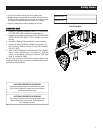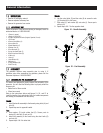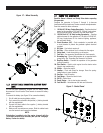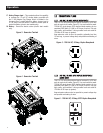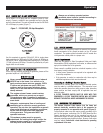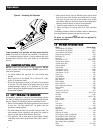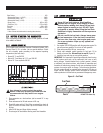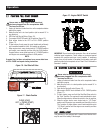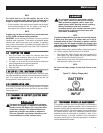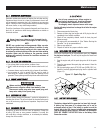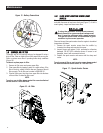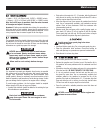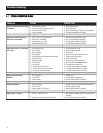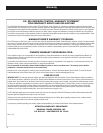
11
NOTE:
The switch must be in the RUN position. Use one of the
generator’s receptacle outlets along with the included battery
charger to charge the battery while the generator is running.
To start manually, firmly grasp the recoil handle and pull slowly
until increased resistance is felt. Pull rapidly up and away to
start engine. Then follow the same choke sequence.
NOTE:
If engine fires, but does not continue to run, move choke lever
to FULL CHOKE and repeat starting instructions.
IMPORTANT: Do not overload the generator. Also, do not overload
individual panel receptacles. These outlets are protected against
overload with push-to-reset-type circuit breakers. If amperage
rating of any circuit breaker is exceeded, that breaker opens and
electrical output to that receptacle is lost. Read “Don’t Overload the
Generator” carefully.
1. Shut off all loads, then unplug the electrical loads from
generator panel receptacles. Never start or stop the engine
with electrical devices plugged in and turned on.
2. Let engine run at no-load for several minutes to stabilize the
internal temperatures of engine and generator.
3. Move Run/Stop switch to OFF position.
4. Close fuel valve.
The engine is equipped with a low oil level sensor that shuts down
the engine automatically when the oil level drops below a specified
level. If the engine shuts down by itself and the fuel tank has
enough gasoline, check engine oil level.
If the system senses a low oil level during operation, the engine
shuts down. The engine will not run until the oil has been refilled
to the proper level.
Storage batteries give off explosive hydrogen
gas while recharging. An explosive mixture will
remain around the battery for a long time after
it has been charged. The slightest spark can
ignite the hydrogen and cause an explosion.
Such an explosion can shatter the battery and
cause blindness or other serious injury.
Do not permit smoking, open flame, sparks
or any other source of heat around a battery.
Wear protective goggles, rubber apron and
rubber gloves when working around a battery.
Battery electrolyte fluid is an extremely
corrosive sulfuric acid solution that can cause
severe burns. If spill occurs flush area with
clear water immediately.
NOTE:
The battery shipped with the generator has been fully charged.
A battery may lose some of its charge when not in use for
prolonged periods of time. If the battery is unable to crank the
engine, plug in the 12V charger included in the accessory box
(see section "Charging the Battery"). RUNNING THE GENERATOR
DOES NOT CHARGE THE BATTERY.
Use battery charger plug to keep the battery charged and ready for
use. Battery charging should be done in a dry location.
1. Plug charger into “Battery Charger Input” jack, located on the
control panel. Plug wall receptacle end of the battery charger
into a 120 Volt AC wall outlet (Figure 13).
2. Unplug battery charger from wall outlet and control panel jack
when generator is going to be in use.
NOTE:
Do not use the battery charger for more than 48 hours at one
charge.
Figure 13 - Battery Charger Jack
&%88)6=
',%6+)6
-2498
It is important to perform service as specified in the Maintenance
Schedule for proper generator operation, and to ensure that the
generator complies with the applicable emission standards for the
duration of its useful life. Service and repairs may be performed by
any capable person or repair shop. Additionally, emissions critical
maintenance must be performed as scheduled in order for the
Emissions Warranty to be valid. Emissions critical maintenance
consists of servicing the air filter and spark plugs in accordance
with the Maintenance Schedule.
Maintenance



